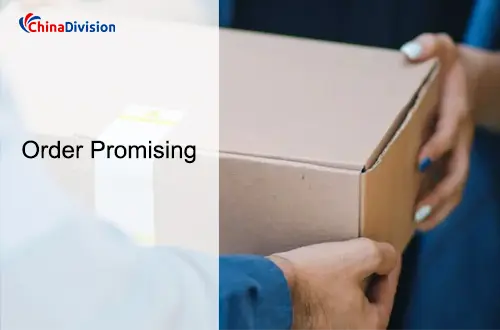How Can Order Promising Improve Supply Chain Efficiency?
Providing reliable delivery promises at the time of order confirmation is key to improving customer satisfaction for e-commerce sellers and B2B companies. This is where Order Promising comes into play.
Table of Contents
The challenge facing B2B companies and e-commerce sellers has evolved beyond simply securing orders to efficiently and reliably fulfilling them. Customers expect shorter delivery cycles, greater transparency, and reduced fulfillment risk, yet the complexities of the supply chain (such as dispersed inventory, fluctuating logistics, and demand forecasting discrepancies) make it difficult for companies to accurately deliver on their promises.
As a global order fulfillment service provider, Chinadivision has been deeply involved in the supply chain field for many years. This article will analyze the core logic of Order Promising from a service provider's perspective and answer the in-depth questions that businesses are most concerned about.
What is Order Promising? Why is it so important?
Order promising is the process of making commitments to customer order delivery times, quantities, and feasibility within supply chain management. It goes beyond simple inventory checks and requires a comprehensive assessment of factors such as multi-warehouse inventory distribution, production schedules, logistics timelines, and tariff policies to ensure that the promised delivery plan is realistically achievable.

Order promising, as a core component of supply chain management, is the key to addressing this pain point. By integrating inventory, production capacity, and logistics data, it provides companies with available-to-promise (ATP) and capacity-to-promise (CTP), ensuring that delivery commitments to customers are both accurate and feasible.
In the context of global operations, global order promising has become a key technology for multinational companies to coordinate inventory, production, and logistics across multiple locations.
In the supply chain, order promising bridges the gap between customer expectations and operational realities. It answers the following key questions:
"When can I expect to receive my order?"
What does an order promise include?
A professional order promise goes beyond simply providing a date—it considers multiple factors to ensure that the date is realistic:
Inventory status—whether the product is in stock, in transit, or requires manufacturing. Logistics Lead Time – Domestic or global order promises need to account for shipping times, customs clearance, and last-mile delivery.
Order Priority Rules – High-value customers or urgent orders may receive priority.
Fulfillment Capacity – Available warehouse resources, labor, and packaging speed.
At ChinaDivision, we integrate all of these variables into our order fulfillment system so our clients can confidently tell their customers when they can expect to receive their products.
Order promises aren't just a simple "in stock" or "out of stock" response; they're a complex decision-making process that considers multiple factors, including inventory levels, production capacity, supplier lead times, and logistics times. An excellent order promise system can:
Improve customer satisfaction (through accurate delivery promises)
Reduced inventory costs (through precise available-to-promise calculations)
Enhance supply chain visibility (through real-time data integration)
Improve operational efficiency (through automated decision-making)
Why do we need order promises?
Boost customer trust
Accurate delivery promises reduce order cancellations and complaints, strengthening brand loyalty.
Optimize inventory utilization
Avoid stock-outs caused by over-promising or excess inventory caused by under-promising. Reduce fulfillment costs
Smartly assign orders to optimal warehouses, reducing cross-regional transfers and emergency logistics expenses.
Supporting a global footprint
For cross-border business, there are complexities to consider, such as customs clearance, distribution networks, and time zone differences across countries. The Order Promising system automates these complexities.
With supply chain disruptions more common than ever, accurate order promises are not only a customer service advantage but also a survival strategy. Companies that can reliably deliver on time retain customers and gain a competitive advantage, while those that fail to do so risk reputational damage and lost sales.
Order Promising Core Functionality and Implementation Logic
1. Available to Promise (ATP)
ATP is a fundamental function of the order promising system, calculating in real time the quantity of currently available inventory that can be immediately committed to customers. ATP is the current inventory level available to fulfill new orders. The calculation formula is:
ATP = Current Inventory - Committed Orders + Expected Arrivals (e.g., orders in transit, in production).
Chinadivision's digital warehouse management system (WMS) tracks global inventory movements in real time and combines this with forecasted ATP for each warehouse to ensure accurate inventory commitments.
2. Capability to Promise (CTP)
When inventory is low, the CTP function evaluates factors such as production capacity and procurement cycle time to determine when customer demand can be met through production or procurement. CTP expands the scope of ATP to consider not only inventory but also production capacity, logistics resources, and supplier delivery cycles.
Chinadivision integrates its supplier collaboration platform and intelligent logistics network to simulate fulfillment capabilities under different scenarios and provide dynamic CTP.
3. Simulation and What-If Scenario Analysis
Companies often need to answer questions such as, "If order volume surges by 30%, can we deliver on time?" or "What is the impact on delivery timelines if some inventory is transferred from warehouse A to warehouse B?" Chinadivision's system allows you to run various simulation scenarios, helping you make more informed decisions and developing risk mitigation plans in advance.
What factors should an Order Promising system consider?
An effective order promising system relies not only on inventory data but also comprehensively considers:
Current inventory and in-transit inventory
Production capacity and resource availability
Transportation routes and timeliness
Customer priorities and service levels
Simulations and what-if scenarios
These factors collectively determine whether orders can be fulfilled on time and whether supply strategies need to be adjusted.
For cross-border e-commerce and global B2B companies, orders may originate from multiple countries, with inventory distributed across multiple warehouses or distribution centers. Global Order Promising can:
Coordinate inventory and shipping capacity across multiple supply locations
Automatically select the optimal supply location and transportation method
Support component substitution and order splitting for increased fulfillment flexibility
Common pain points and answers to Order Promising
Can Order Promising handle global orders?
Yes. Global order promises integrate the inventory and capacity of multiple warehouses and suppliers worldwide, optimizing the fulfillment process and achieving optimal delivery time and cost.
How do you handle global order promises for multi-location inventory?
For businesses with multiple warehouses, our system uses intelligent allocation logic, taking into account:
The distance between the customer's location and each warehouse
The inventory levels and replenishment plans of each warehouse
The time and cost of different shipping methods
Tariffs and cross-border logistics restrictions
The system automatically recommends the optimal fulfillment solution, balancing delivery speed and logistics costs.
How do you maintain promise accuracy when the supply chain is unstable?
We employ the following strategies to address supply chain fluctuations:
Dynamic safety stock calculation: Automatically adjusts based on supplier reliability data
Real-time early warning system: Provides early warning of potential delays
Multi-supplier fallback: Automatically switches to alternative suppliers
Intelligent buffer time allocation: Reserves an appropriate buffer based on risk level
How can Chinadivision enhance your order promises?
Global fulfillment network
Covering over 200 countries and regions, with over 50 overseas warehouses, we can calculate the optimal delivery route in real time.
Powered by intelligent technology
Big data analysis provides dynamic ATP/CTP and risk early warning.
Customized Services
Supporting a variety of models, including B2B large-volume orders, e-commerce small packages, and dropshipping, flexibly adapting to business needs.
Cost Optimization
Reduce fulfillment costs by 15%-30% through intelligent warehouse distribution and logistics price comparison.
Whether you're a B2B company facing the challenges of global supply chain coordination or an e-commerce seller striving for an exceptional customer experience, Chinadivision's professional order fulfillment services offer tailored solutions.
In the era of "delivery as a service," order promises are more than just a technical tool; they're a reflection of a company's competitive edge. Chinadivision is committed to working with you to ensure every promise becomes a cornerstone of customer trust through intelligent order fulfillment services.





